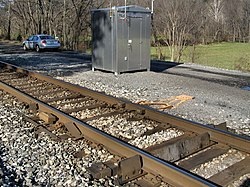Uncategorized
Uncovering the Ohio Train Wreck: The Railroad Defect Detector

Since we’re in the mood today we’re going to talk about the Railroad Defect Detector. We want to know more about its role in the Ohio Train Wreck.
From the point of view of an ISO auditor, there is a lot to say about this as a “measuring device.”
Let’s start with a story.
True Railroad Story
I was on an “extra gang” 49 years ago, and our job was to go out and do minor roadbed improvements. We had a crew of four. There were two machines. One was a tamper which picks up the track and tucks the gravel under the ties. The other was a liner, which was 75 yards long and had a steel wire that ran from the front to the back. The job of that thing was to get the rail straight. Or if it was on a curve, get it so that the curve was properly aligned.
My job was to operate a scoop shovel and also, to help set up the liner.
This was the main line, and everybody knew we were out there. The trains ran roughly every hour. These were big freight trains with coal hopper cars and boxcars mainly, but we occasionally saw a tank car or two.
We would go out on the line and work as long as we could. The foreman’s job would be to keep track of the time. Then, his job was to get us off the track before we would get smacked by a train. In that part of the line, there were plenty of little towns and little sidings. Therefore it was pretty easy to find a siding nearby to let the train or trains go by.
The Railroad Defect Detector’s Role in Ensuring Safety: Disco Version
It was us. Rather than lay around on the equipment, they’d spread us out on either side of the track. Our job at the time was to look at the wheels, and if we saw any overheated bearings, we’d tell somebody. We didn’t have direct communication with the train, but we were expected to give a hand signal. The friendly wave that we gave the guy in the “caboose”, better known as the “way car” was a sign that everything was OK.
That was the term “hiball” by the way. We were letting the crew know that they could continue their full speed.
There was legend from the old days to the effect that it was nothing for a burning train to set three or four towns on fire before they knew what was up.
Nowadays, there is no such thing as a caboose. They no longer pay a couple of guys to sit in the back of the train. They replaced all of that eventually with those electronic hot box detectors. The Railroad Defect Detector is taking the place of a human.
We’ll talk about hot boxes later. It’s where one of the bearings on the wheels overheats. Here’s a video.
Measuring Devices
Well, the ISO standard talks extensively aubot measuring devices. It’s up to the organization, in this case it would be the railroad, to determine how to set this system up. They also to maintain the calibration, and make sure someone “trained” is doing the calibrating.
In someplace like Ohio, they need to also send someone out with a device called a “switch broom” and knock any ice and snow off of them every time it snows.
ISO Auditor Line of Questioning
So there is a measuring device, the first question would be, was it functioning on the day of the wreck? What is the calibration interval? When is the last time the signal department maintained this thing?
In the railroad, there is such a thing as a signal department. We thought those guys had a pretty cushy job. A lot of them were college educated. They are making about $34 an hour at the time being, according to the link below.
This is another one of those jobs that is union, and if they hire you, you start as a sort of extra temp. When you build up enough seniority you can eventually bid into a regular job.
Side issue, NS gets a 1.8 rating on Indeed for employee happiness. People are ticked off. The Railroad Defect Detector does not pick up bad attitudes.
The Railroad Defect Detector: Calibration Interval and Records
So if I were sleuthing this out, I would pull the calibration records for this thing. That would lead us to the basic question, which was whether or not it was working properly at the time. None of the released information so far suggests that there was anything wrong with this particular one.
But, this particular railroad detector is not the one I would be interested in. I would be interested in the one right before this one.
Come to find out there is a public database of these things. I put the link down below. I would speculate that the previous one would be in Salineville, which is 27 miles away.
Who knew there would be a research paper on this?
My poor old dad looked down his nose a bit on highbrow researchers. He was suspicious of educated people anyway.
In this case, there was a 2020 publication from some people at the U of Texas Rio Grande on this topic. The Railroad Defect Detector is subject of academic research. Who knew?
According to that, at a speed of about 40 MPH, if they’re set up right, these things will detect temperatures 20 degrees centigrade above ambient. So if it’s 27 degrees centigrade outside, a nice warm spring day in Ohio, this thing would tell you if the bearing was 47 degrees, which is about 120F.
So we know from the video that the “defective” car had sparks spewing out of it prior to the wreck.
Is it possible for a rail car bearing to break “out of the blue?” If it is anything like a car bearing, most of the time it’ll get “warm” before it turns in to a mass of sparks and bursts into flames.
So, the gadget in Salineville is important to the investigation. It had also better be in working order, with calibration records.

Here’s a CNN article to the effect that a series of these things did not actually pick up the defect until much after it became an issue:
https://www.cnn.com/2023/02/25/us/ohio-train-derailment-bearing-vibration/index.html
The Railroad Defect Detector’s Role in Ensuring Safety: Calibration Records
So now the plot thickens. There should be calibration records for this and any of the other hot box detectors, all the way back to St. Louis.
These records should have on them the last calibration date, who calibrated them, and what made them qualified to do so.
Also, there should be records of the last time any adjustments were required, so we know if any of these things are “finnicky.”
This is why you keep calibration records. It’s so you, the organization, can prove you did things right.

And at this point, if you were the railroad, you’d be expected to come up with these, and not just the current ones. A lawyer might make the argument that these things are inherently fragile, and use all of your calibration records to convince an uneducated jury otherwise.
And, also, if you were the railroad, you would be expected to keep these things “free from unintended alteration” like the standard says, because these are records of conformity.
The Railroad Defect Detector’s Role in Ensuring Safety: The Railroad’s Point of View
According to a recent news report, the railroad is now checking every one of these things in their system to find out what the status is.
Theoretically they should be able to do this at any time, if their calibration and service records are up to date.
If the lawyers find out that a lot of these are malfunctioning, they will use this as persuasion. Remember in a civil case, the standard of proof is “preponderance of the evidence.” So, they will try to be melodramatic and paint the picture that the railroad was negligent. Maybe they will be right, we don’t have all of the information.
There is an ongoing incentive on the part of the railroad to keep costs under control. They will be tempted to do what we old railroaders used to call a “half assed job.” If they did that, it will be found out soon enough.
The Requirements
This is another can of worms. In an ISO certified place, it would be up to “the organization” to decide what needs to be measured, how to measure it, and also the traceability and calibration of any measuring equipment.
In the case of the railroads, it’s not completely up to the railroad. It’s up to the Federal Railroad Administration.
They are the ones that set up the requirements for these things. This includes the installation requirements, and the calibration and monitoring. It’s interesting. You have to put it X number of feet away from a crossing, on flat track, and there are a lot of other requirements.
I’ve linked the requirements below.
So who checks to see if they’re actually doing their job? Well, there is an FRA inspector that comes around periodically to check all this. How good of a job do they do? Are they adhering to the required audit and/or inspection schedule? Are they following the installation and maintenace rules?
Well, this is another can of worms that I am not going to weigh in on except to say it’s hard for the government to do its job right now. That goes double for this investigation.
We’re living in a world where an incident that took place on national TV is still not completely investigated more than two years after the fact.
Alarms in General
Ah, here are some videos which I hope you will like:
So this is the story. There are a lot of different kinds of alarms. This one on its face is very important. It takes the place of a human inspector that is no longer around. The congenial guy in the caboose was “downsized” and replaced by this techology decades ago.
It’s the human-alarm interface that is problematic.
Assuming that the alarm works, which is something that is in doubt, it’s still up to a human, with some level of training, to make a decision.
If it is found out that the alarm system in this place functions crappily, gives false alarms and otherwise is marginally useful, a lawyer will use that information in the upcoming class action lawsuit.
So, that will be the area of inquiry.
I am still standing by the remarks that an alarm of any kind is a sign of human failure. We’ll be looking at a few more things in this but we are slowly able to piece together a prediction about what is going to happen.
If anybody is interested in a professional opinion on the topic of people not doing their jobs, I believe I am equipped to help.https://jimshell.com/business-systems-consulting/
Links and References
Signal Database
https://database.defectdetector.net/
Hot Box Detector Efficacy
DOT Information
Checking Hotbox Detectors
![]()










